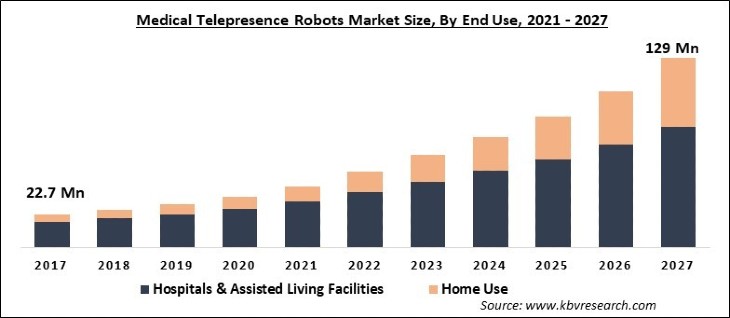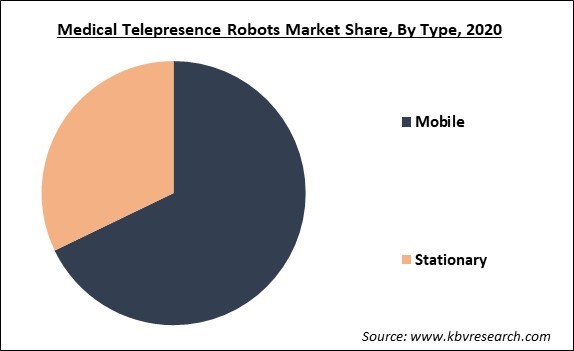The Global Medical Telepresence Robots Market size is expected to reach $129 Million by 2027, rising at a market growth of 20.7% CAGR during the forecast period. Medical telepresence robot refers to a robot that helps in offering efficacious medical care to the patients while doctors and other medical staff are sitting at remote places. A medical specialist utilizes monitors and cameras to look at the patient's body from various angles and also get instruments through which the doctor treats the remote patient. These medical telepresence robots are majorly utilized for surgical processes like orthopedics, cardiac surgery, cardiology, or neurosurgery, in which, doctors or other medical specialists cannot physically present all the time in the whole procedure due to the long distances and huge costs incurred by travel.
The increasing government initiatives & investment to provide support for the research & development in AI and robotics in various nations is bolstering more innovations & development in this field and is motivating new players to enter the market. The growing number of market players providing innovative solutions and more focusing on R&D according to the shifting needs have led to the launch of various innovative solutions, which would further fuel the market growth.

The outbreak of the global COVID-19 pandemic has impacted almost every section of society. Some sectors of the business domain have witnessed a positive impact of the pandemic whereas some have witnessed a negative impact on their businesses. The medical telepresence robots market has seen a positive impact on the COVID-19 pandemic. It is because these robots help healthcare workers to assist and treat covid patients by maintaining social distancing.
There are many medical facilities like hospitals, clinics, and others, which have adopted telepresence robots to carry out their treatment for patients without coming in contact with the patients. In addition, the imposed lockdown in the initial phase of the pandemic has stopped the movement across various nations and the increasing cases of coronavirus have made it impossible for doctors to be present and visit several places. The key market players are also heavily investing in R&D to fulfil the increasing demand to make sure about the launch of telepresence robots with advanced medical features. Thus, the adoption of medical telepresence robots has also increased due to the pandemic, which would augment the overall growth of the market in the coming years.
There are various governments across the globe that is taking numerous initiatives to augment the adoption and innovations of artificial intelligence and robotics. These initiatives motivate companies to carry out new developments to better support the healthcare sector. Medical telepresence robots play an important role in the healthcare sector as it helps in establishing a connection between a healthcare professional and the patients.
To curb the spread of the coronavirus, several steps were taken including social distancing, travel band, and others. Doctors and other medical professionals are at more risk as they ought to come in contact with the patients for their treatment. However, to prevent doctors from getting infected by the virus, many medical facilities have started adopting these robots.
Any technologically advanced robot is built by using various technologies and tools, which increases the overall cost of the robot and makes it expensive for hospitals and other medical organizations to adopt it. In addition, technical glitches may arise while using these robots, which may hamper the efficiency of the robot in monitoring the patients and further lead to operational failures.

Based on Component, the market is segmented into Microphone, Speaker, Display, Sensors & Control System, Camera and Power Source. The camera segment accounted for the highest share in the market in 2020. It is because cameras are important for the functioning and working of the robot. The display, camera, speaker, and microphone parts are crucial components of telepresence robots since they help in establishing two-way communication and the virtual presence of the customers.
Based on Type, the market is segmented into Mobile and Stationary. The mobile segment acquired the highest revenue share in the medical telepresence market in 2020. This segment is also anticipated to garner the fastest growth during the forecast period. It is due to the features like head motion, adjustable height, autonomous navigation, and obstacle avoidance, which help in the smooth and efficient delivery of services and virtual supervision, thus, help in effective teleconsultation.
Based on End Use, the market is segmented into Hospitals & Assisted Living Facilities and Home Use. The home-use segment is projected to acquire the highest growth rate during the forecast period. It is due to the growing geriatric population, the increasing prevalence of chronic diseases that require regular supervision, and the accessibility of some inexpensive telepresence robots in the market.
| Report Attribute | Details |
|---|---|
| Market size value in 2020 | USD 34.7 Million |
| Market size forecast in 2027 | USD 129 Million |
| Base Year | 2020 |
| Historical Period | 2017 to 2019 |
| Forecast Period | 2021 to 2027 |
| Revenue Growth Rate | CAGR of 20.7% from 2021 to 2027 |
| Number of Pages | 193 |
| Number of Tables | 357 |
| Report coverage | Market Trends, Revenue Estimation and Forecast, Segmentation Analysis, Regional and Country Breakdown, Companies Strategic Developments, Company Profiling |
| Segments covered | Component, Type, End Use, Region |
| Country scope | US, Canada, Mexico, Germany, UK, France, Russia, Spain, Italy, China, Japan, India, South Korea, Singapore, Malaysia, Brazil, Argentina, UAE, Saudi Arabia, South Africa, Nigeria |
| Growth Drivers |
|
| Restraints |
|
Based on Regions, the market is segmented into North America, Europe, Asia Pacific, and Latin America, Middle East & Africa. The Asia Pacific is projected to procure the fastest growth rate in the medical telepresence robots market during the forecast period. This growth is attributed to the increasing government initiatives regarding robotics and artificial intelligence and the high adoption of robotics in the healthcare industry. Additionally, the surging number of market players in this region, especially in China and Japan, is bolstering the growth of the regional market.
Free Valuable Insights: Global Medical Telepresence Robots Market size to reach USD 129 Million by 2027
The market research report covers the analysis of key stake holders of the market. Key companies profiled in the report include Blue Ocean Robotics, TELADOC HEALTH, INC., OhmniLabs, Inc., VGo Communications, Inc. (Vecna Technologies, Inc.), Xandex, Inc., Double Robotics, Inc., Amy Robotics Co., Ltd., Ava Robotics, Inc., and AXYN Robotics.
By Component
By Type
By End Use
By Geography
Companies Profiled
The medical telepresence robots market size is projected to reach USD 129 Million by 2027.
High demand for telepresence robots due to the COVID-19 pandemic are driving the market in coming years, however, High cost of the robots limited the growth of the market.
Blue Ocean Robotics, TELADOC HEALTH, INC., OhmniLabs, Inc., VGo Communications, Inc. (Vecna Technologies, Inc.), Xandex, Inc., Double Robotics, Inc., Amy Robotics Co., Ltd., Ava Robotics, Inc., and AXYN Robotics.
The expected CAGR of the medical telepresence robots market is 20.7% from 2021 to 2027.
The medical telepresence robots market has seen a positive impact on the COVID-19 pandemic. It is because these robots help healthcare workers to assist and treat covid patients by maintaining social distancing.
The North America emerged as the leading region in the medical telepresence robot market with the highest revenue share in 2020.
Our team of dedicated experts can provide you with attractive expansion opportunities for your business.

